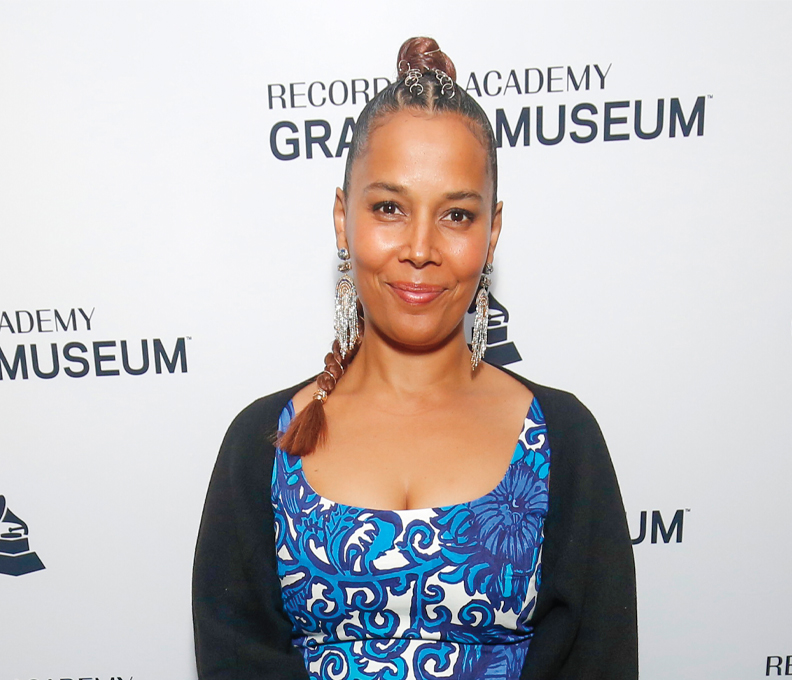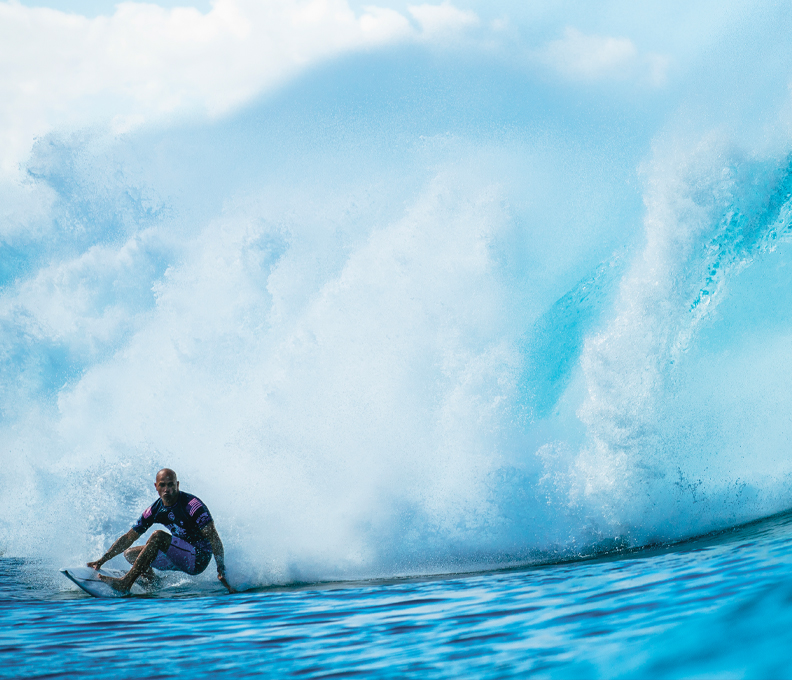Airbnb Cofounder Joe Gebbia Looks to His Next Venture, Samara
Using design to solve problems, the entrepreneur is tackling the country’s housing challenges through his new dwelling start-up
by Alix Sharkey
June 30, 2023
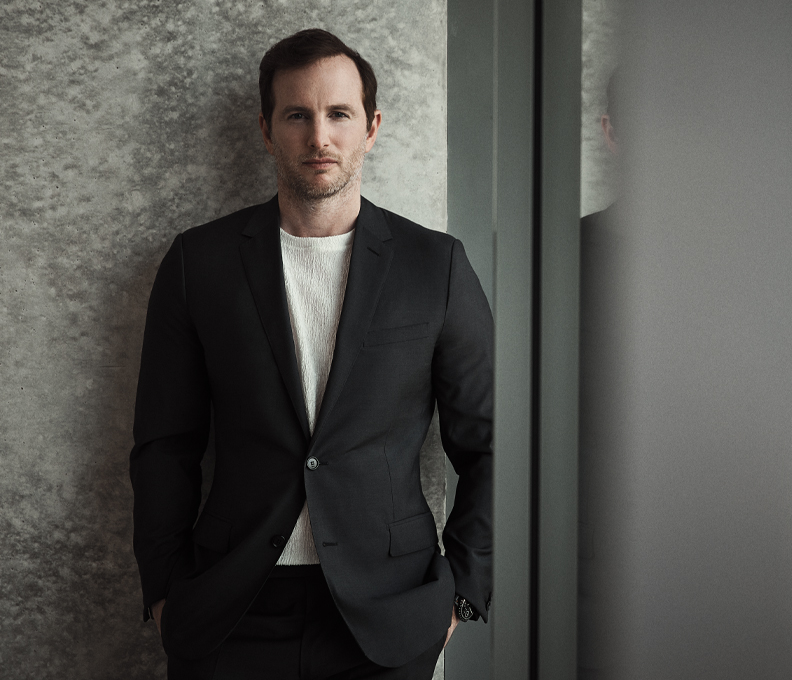
Joe Gebbia / Photo: Courtesy of Miller Mobley
“Am I a designer first and then an entrepreneur, or vice versa?” says Joe Gebbia, carefully repeating my question. He speaks methodically, weighing each word before it takes shape. “Well, it’s chicken-and-egg. The act of design is identifying a problem, then coming up with a solution. You have to envision something that doesn’t yet exist and then you have to go make it.”
Today, Gebbia is best known as one of America’s most successful businessmen, a philanthropist and visionary who has revolutionized the hospitality industry and whose net worth last year was estimated by Forbes at $7.4 billion. Since he regards himself as extremely fortunate and wealthy far beyond his needs, he has pledged in writing to give away half his riches before he dies. Yet barely a decade and a half ago, Gebbia was asking himself a question that is all too familiar for many lower-income Americans: How am I going to pay the rent?
It was 2007 and Gebbia and roommate Brian Chesky, both 20-something designers, were gainfully employed yet barely getting by in San Francisco, a city whose housing market had reached boiling point thanks to the massive boom in Silicon Valley’s tech industries. When their landlord suddenly raised their rent by an exorbitant 20 percent, they found themselves strapped for cash.
Their simple answer? Capitalize on a unique opportunity. Gebbia and Chesky knew that the city was gearing up for the annual Industrial Designers Society of America conference, causing a scarcity of affordable lodging with hotels all over the city fully booked. In order to make ends meet, they decided to offer air mattresses on their apartment floor and provide breakfast to conference attendees, via a hastily built website called AirBed and Breakfast. What started as a way to monetize their extra space would rapidly gain traction as a new cultural paradigm and evolve into a global phenomenon, as Gebbia, Chesky and third cofounder and original coder Nathan Blecharczyk realized the immense potential of their concept.
What’s often overlooked, however, is Gebbia’s keen eye for elegant design and how it played a pivotal role in Airbnb’s growth. When the platform struggled to gain traction in New York City, Gebbia and Chesky identified a common problem: Hosts were uploading inferior photos of poorly organized accommodations that failed to effectively showcase their listings. Acting swiftly, Gebbia and Chesky rented a camera and embarked on a mission to capture artfully framed, high-resolution images of the properties, with rooms and amenities presented at their most appealing.
The impact was immediate. Revenue from Airbnb listings in the city doubled, leading to the eventual creation of the Airbnb Photography Program, a service that now links hosts with photographers. Furthermore, Airbnb’s emphasis on design and aesthetics influenced interior-decor trends, inspiring homeowners to create inviting and unique spaces. For Gebbia, the notion that a business problem or social issue can be resolved through better design comes naturally. Born in 1981 as one of two siblings in the Atlanta suburb of Lawrenceville, he swiftly developed an affinity for art, drawing and constructing models—as well as earning a few bucks in pocket money. “As a kid,” he recalls, “I was always finding ways to get ahead. I’d mow lawns, wash cars, do little business moves, and also sell my drawings.”
After graduating from local Brookwood High (“A great school—I took a ton of art classes there”), Gebbia pursued degrees in industrial design and graphic design at the renowned Rhode Island School of Design (RISD). It was during his time at RISD that Gebbia honed his skills, blending his artistic sensibilities with a deep understanding of user experience and functionality. “Studying business is great,” he says, “but there’s a good argument for an art and design education being just as powerful as a business education.” Even before he enrolled at RISD he had already been deeply influenced by the work of industrial design duo Charles and Ray Eames. Widely regarded as two of the most important figures in 20th-century design, the husband-and-wife team established their studio in Los Angeles in 1943, integrating functionality, aesthetics and innovation. Their iconic furniture, films and architecture left an indelible mark, shaping the way we perceive and experience design to this day.
“My love for design started with discovering the Eameses and their work,” says Gebbia. “Their motivation inspired me. Their ethos was democratizing great design. They wanted to create the most elegant and efficient artifacts, but also make them available to the greatest number of people at the lowest possible cost.”
After graduating from RISD, Gebbia began his career as a designer at Chronicle Books in San Francisco, teaming up with RISD classmate Chesky to share an apartment. Little did they know that this move would revolutionize the way we perceive our homes and how to use them. Even the notion of what constitutes a living space has been profoundly changed, while the once rigid delineation between work and home life has also been blurred, a cultural shift exacerbated by the Covid lockdown. And so it’s hardly a surprise that in recent years, Gebbia’s innovative mind eventually turned to a new challenge: Designing affordable and sustainable housing developments that could help tackle the global housing crisis. At first glance, this may seem like an odd pivot, but for Gebbia the connection is clear: Both Airbnb and his new housing venture, Samara, are about using technology to connect people in innovative ways. Indeed, Samara began as a research and innovation team within Airbnb and has now become a privately funded start-up. Its first product, Backyard, introduces a novel update on the accessory dwelling unit (ADU)—fully customizable, factory-made modular homes that offer flexible housing options.
“The idea of ADUs became much more culturally acceptable and popular during the Covid pandemic, when people’s attitudes toward their homes and how they relate to them changed drastically,” Gebbia says. “Today, 50 percent of Americans spend at least one day a week working from home, and one in every five households has at least two adult generations living together.”
People are now more aware of how they use space, says Gebbia, and want to maximize its value. “For some, that means renting out space to generate income. Others want extra space to be more productive, for home offices, workshops or studios. Some want extra space to follow their passion—be it practicing yoga, working on cars or motorcycles, or making art or ceramics. Still others need living space for extended family, perhaps in-laws or elderly parents, even adult children. And of course, some people will do two or more of these things over time. So we designed Backyard units to easily convert from one type of use to another, evolving with the customer.”
Perhaps the most exciting aspect of Backyard is its user-friendly interface. Via the samara.com website, customers can choose one of three prefabricated options—studio, one- or two-bedroom, ranging in size from 420 to 690 square feet—and then customize according to taste, selecting layout, colors, windows, doors, decks, interior and roof finishes and solar-panel configuration. Built on a precision-engineered steel frame resistant to mold, rot and termites and available with ceilings up to 10 feet 10 inches, Backyard units feature an integrated air-purification system with ionizer, premium all-electric appliances, integrated task lighting, and ample storage.
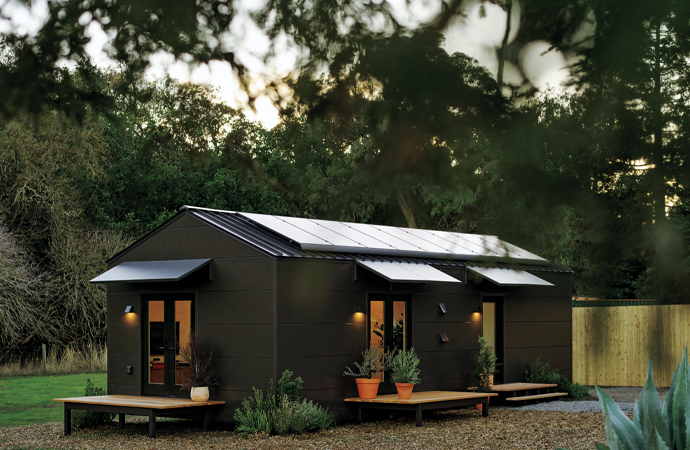
Exterior of Samara’s Backyard accessory dwelling unit / Photo: Courtesy of Samara
Another key aspect of Backyard is sustainability. Long interested in environmental issues, Gebbia sees Backyard as an opportunity to apply his passion for sustainability to the realm of housing. The modular units are designed to be energy-efficient and environmentally friendly, built with sustainable materials. With integrated rooftop solar panels to make them self-powered, they can generate more energy than they consume, resulting in lower utility bills for homeowners. And, says Gebbia, the units are designed and constructed to last a lifetime.
Samara will manage the construction process from end to end—including surveying, permitting, unit fabrication, delivery, utility hookups and installation—ensuring Backyard units are ready to inhabit on time, within budget and with minimal disruption to existing property. “Creating your own home from scratch is hard,” says Gebbia. “The building process is complicated for the average homeowner. So we decided we were going to simplify everything. We knew that would have broad appeal, because in the same way that Airbnb made it easy to rent out homes, we’re making it easy for people to order, configure and purchase an extension to the home—a flex space, which can be adapted as your needs change.”
Right now, Backyard’s main market is the Bay Area and Southern California, where regulations have been updated to address the state’s imminent housing crisis and rapidly increasing cost of living. In order to facilitate the urban densification of the state, the installation of an ADU is now a homeowner’s right by law. “California is ahead of the curve in many ways,” says Gebbia. Since the law was recently changed to make it easier for homeowners to install an ADU on their property, he claims, the number of permits issued has increased 17-fold. “That incredible growth shows us the demand is there: When you remove the friction, the impediments, the market starts to balloon.”
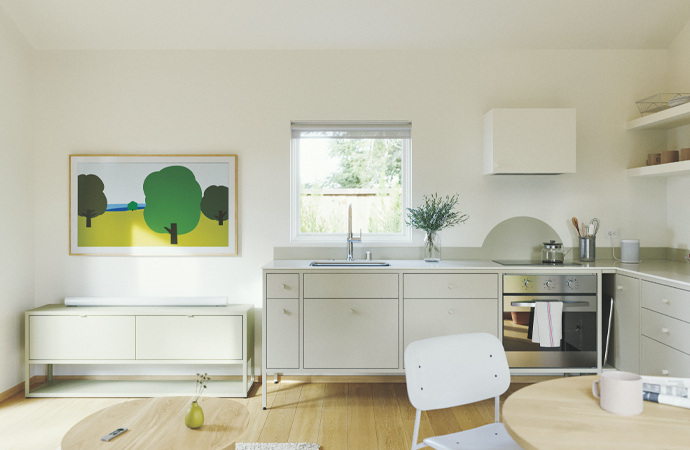
Interior of a Backyard unit / Photo: Courtesy of Samara
And with prices starting at $289,000 including everything from survey to installation, it’s no wonder that Backyard is already drawing attention across the nation from authorities searching for novel ways to address housing needs. By offering high-quality, low-cost starter homes, the project could address housing affordability and provide flexible living options for young couples or individuals.
Gebbia says at least eight other states have been in contact and are looking to revise their own legislation on ADUs to model or resemble California’s. “It’s a movement that’s expanding pretty quickly across the country as other states recognize the benefits of using residential space more wisely.”
Private companies, too, are looking to leverage Gebbia’s modular housing model. “Developers have reached out,” he says, “asking us to build communities and create low-rise neighborhoods on unused or reclaimed land. That could mean affordable housing for residents in areas where they maybe otherwise could not afford to rent.” This aspect of the Backyard project also aligns with the ethos of airbnb.org, an organization Gebbia helped start to provide housing for displaced individuals during natural disasters and refugee crises, making use of Airbnb’s global community of hosts.
“Airbnb.com helped build one of the largest humanitarian platforms on the planet. If a natural disaster is big enough to be on TV, the chances are that we’ve already activated airbnb.org to offer shelter to people whose homes have been burned down, flooded out, reduced to rubble or blown away by a typhoon. For me, it’s incredible to see how generous people are when you make it easy for them to give back. I see that every day. Airbnb.org offers generosity at scale all over the world.”
Gebbia also supports the Malala Fund, which advocates for girls’ education worldwide. With more than 130 million girls lacking access to education, the fund works to provide opportunities for them, inspired by the activism of Malala Yousafzai, who survived a Taliban attack in Pakistan and became a global champion for education.
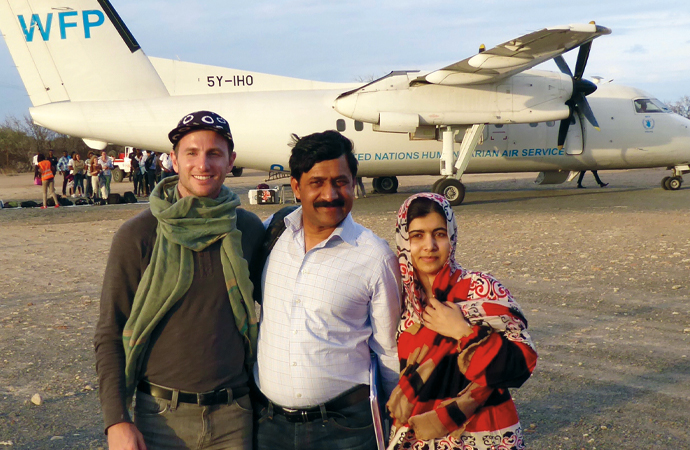
With Ziauddin and Malala Yousafzai. Gebbia is a supporter of the Malala Fund / Photo: Courtesy of Malala Fund
The environment is another philanthropic passion. Gebbia is a large donor to The Ocean Cleanup, an organization dedicated to addressing the problem of plastic pollution in oceans. Through scalable cleanup efforts and the interception of plastics at the source, the Netherlands-based nonprofit aims to reduce the accumulation of plastic waste.
Perhaps most impressively, in 2016 Gebbia signed on to The Giving Pledge, an initiative launched by Warren Buffett and Bill Gates, whereby some of the planet’s wealthiest people have promised to donate at least half of their wealth to build pathways for future creatives and entrepreneurs worldwide, no matter their age, gender or background. But in a time so marked by avarice and conspicuous consumption, what inspired him to pledge half his worldly fortune to helping others?
Once again, his words are deliberate, carefully chosen pebbles of meaning, arranged with artful precision. “I feel so incredibly lucky, so incredibly fortunate. And with that comes a feeling of responsibility to give back to others less fortunate.”
Any doubts he had were quickly dispelled once he spoke with Buffett, who explained why he himself had signed up to give away half of his vast wealth. “Talking to him really tipped me over the edge, and I have never regretted it,” Gebbia says. “Warren Buffett is a Jedi of philanthropy.”
